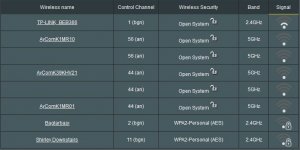joebloogs
Regular Contributor
5Ghz on my Rt-AC68U is worse than 2.4Ghz and what ever i done has not improved it...(no complaints with 2.4Ghz)
Was running latest stock firmware up to now with no luck, so i switched over to Merlin 386.3.2 but still no joy!
Is there some secret setting i need to change to get the 5Ghz working?
I've done a site survey to check visible networks nearby and there are few 5Ghz signals but they are all VERY low.
Changed and tested different control channels, channel bandwidth, wireless mode but still no luck..
I am in the same room as the router 10-15 feet away with no walls in between, but 5Ghz performance is unstable & poor.
anyone have some advice?
Was running latest stock firmware up to now with no luck, so i switched over to Merlin 386.3.2 but still no joy!
Is there some secret setting i need to change to get the 5Ghz working?
I've done a site survey to check visible networks nearby and there are few 5Ghz signals but they are all VERY low.
Changed and tested different control channels, channel bandwidth, wireless mode but still no luck..
I am in the same room as the router 10-15 feet away with no walls in between, but 5Ghz performance is unstable & poor.
anyone have some advice?


